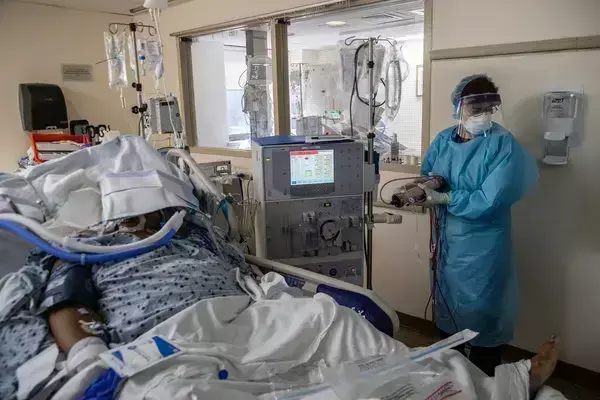- Home
- Medical news & Guidelines
- Anesthesiology
- Cardiology and CTVS
- Critical Care
- Dentistry
- Dermatology
- Diabetes and Endocrinology
- ENT
- Gastroenterology
- Medicine
- Nephrology
- Neurology
- Obstretics-Gynaecology
- Oncology
- Ophthalmology
- Orthopaedics
- Pediatrics-Neonatology
- Psychiatry
- Pulmonology
- Radiology
- Surgery
- Urology
- Laboratory Medicine
- Diet
- Nursing
- Paramedical
- Physiotherapy
- Health news
- Fact Check
- Bone Health Fact Check
- Brain Health Fact Check
- Cancer Related Fact Check
- Child Care Fact Check
- Dental and oral health fact check
- Diabetes and metabolic health fact check
- Diet and Nutrition Fact Check
- Eye and ENT Care Fact Check
- Fitness fact check
- Gut health fact check
- Heart health fact check
- Kidney health fact check
- Medical education fact check
- Men's health fact check
- Respiratory fact check
- Skin and hair care fact check
- Vaccine and Immunization fact check
- Women's health fact check
- AYUSH
- State News
- Andaman and Nicobar Islands
- Andhra Pradesh
- Arunachal Pradesh
- Assam
- Bihar
- Chandigarh
- Chattisgarh
- Dadra and Nagar Haveli
- Daman and Diu
- Delhi
- Goa
- Gujarat
- Haryana
- Himachal Pradesh
- Jammu & Kashmir
- Jharkhand
- Karnataka
- Kerala
- Ladakh
- Lakshadweep
- Madhya Pradesh
- Maharashtra
- Manipur
- Meghalaya
- Mizoram
- Nagaland
- Odisha
- Puducherry
- Punjab
- Rajasthan
- Sikkim
- Tamil Nadu
- Telangana
- Tripura
- Uttar Pradesh
- Uttrakhand
- West Bengal
- Medical Education
- Industry
Blood Urea Nitrogen-to-Albumin Ratio Predicts 28-Day Mortality in ICU Patients with CKD: Study

Researchers have found in a new study that Blood Urea Nitrogen-to-Albumin Ratio (BAR) shows a significant association with 28-day mortality risk in ICU patients suffering from chronic kidney disease (CKD), highlighting its potential as a valuable tool for mortality risk stratification.
Chronic kidney disease (CKD) is prevalent worldwide, with patients facing significant mortality risk in intensive care units (ICUs). Early identification of high-risk CKD patients is crucial for improving clinical outcomes. The blood urea nitrogen to albumin ratio (BAR) is a simple and measurable indicator, but its relationship with 28-day mortality in CKD patients is not well established. This study aimed to investigate this association.
They conducted a retrospective analysis of eligible CKD patients from the MIMIC IV database. The association between the BAR and 28-day mortality was assessed using Kaplan-Meier survival curves, multivariable Cox regression models, and restricted cubic spline models. Results: A total of 4,625 patients were included, with a 28-day mortality rate of 25.2%. Kaplan-Meier survival curve analysis indicated that patients in the high BAR tertile had significantly lower survival probabilities than those in the low BAR tertile.
The adjusted Cox regression model showed that compared to low BAR patients (T1 ≤ 9.8 mg/g), those in T2 (10.0-17.4 mg/g) and T3 (≥ 17.5 mg/g) had increased risks of 28-day mortality, with HRs of 1.49 (95% CI: 1.26–1.76) and 2.04 (95% CI: 1.73–2.40), respectively. Restricted cubic spline analysis indicated a nonlinear association. The BAR is significantly associated with 28-day mortality risk in ICU patients with CKD and may serve as a valuable tool for mortality risk stratification.
Reference:
He, K., Zhu, Y., Wang, W. et al. Association between the blood urea nitrogen to serum albumin ratio and the risk of mortality in patients with chronic kidney disease: a cohort study. BMC Nephrol 26, 275 (2025). https://doi.org/10.1186/s12882-025-04214-z
Dr. Shravani Dali has completed her BDS from Pravara institute of medical sciences, loni. Following which she extensively worked in the healthcare sector for 2+ years. She has been actively involved in writing blogs in field of health and wellness. Currently she is pursuing her Masters of public health-health administration from Tata institute of social sciences. She can be contacted at editorial@medicaldialogues.in.
Dr Kamal Kant Kohli-MBBS, DTCD- a chest specialist with more than 30 years of practice and a flair for writing clinical articles, Dr Kamal Kant Kohli joined Medical Dialogues as a Chief Editor of Medical News. Besides writing articles, as an editor, he proofreads and verifies all the medical content published on Medical Dialogues including those coming from journals, studies,medical conferences,guidelines etc. Email: drkohli@medicaldialogues.in. Contact no. 011-43720751


